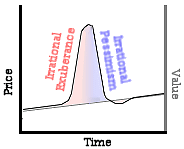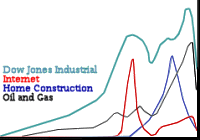I may be the only person on the planet that didn’t know about financial bubbles – but I didn’t. Or at least I didn’t know why they were so dangerous. In any market, there’s an elusive quality – value – which is the actual worth of something. And then there’s a price. When we shop, we look for something that has a price that is either equal to the value, or hopefully even less than the value [a bar-gain]. When we sell something, we try to sell it for a price at least equal to its value, or hopefully even more. Since minute to minute value cannot really be determined with accuracy, the joy of shopping, selling, trading, etc. is in the endless bickering between seller and buyer. And, more or less, price and value stay pretty close to each other in the negotiations of the marketplace.
Sometimes, value rapidly escalates. Something is "hot" or becoming rare, and it becomes desirable, ergo more valuable, and its price rises quickly. In those situations, the value escalates and then tends to level off. An example might be a successful new company on the Stock Exchange, or and old company with an innovative new product.
 That’s not a bubble. A bubble is the situation where the price begins to rise, but there’s no parallel change in real value. How does that happen? Well, our recent Housing bubble is a good example. Prices started going up. In retrospect, it was because money [mortgages] got a lot easier. The loaning institutions found that they could sell their loans and the risk that went with making the loan – so their incentive was to loan more money and the requirements for getting a loan went down. Since money was easy, people were willing to pay more, and prices started going up. When a market begins to go up, investors start investing in it more – more money was available, and the market developed a life of its own, independent of the intrinsic value of the property. In this recent case, loans became irresponsible – allowing terms that were sure to lead to defaults. When something like that gets going, people are "irrationally exuberant" and take on risk that is at the least, imprudent, and often foolhardy. The Market and its investors are in charge of the product’s price, not the actual value of the product being traded. The clock is ticking.
That’s not a bubble. A bubble is the situation where the price begins to rise, but there’s no parallel change in real value. How does that happen? Well, our recent Housing bubble is a good example. Prices started going up. In retrospect, it was because money [mortgages] got a lot easier. The loaning institutions found that they could sell their loans and the risk that went with making the loan – so their incentive was to loan more money and the requirements for getting a loan went down. Since money was easy, people were willing to pay more, and prices started going up. When a market begins to go up, investors start investing in it more – more money was available, and the market developed a life of its own, independent of the intrinsic value of the property. In this recent case, loans became irresponsible – allowing terms that were sure to lead to defaults. When something like that gets going, people are "irrationally exuberant" and take on risk that is at the least, imprudent, and often foolhardy. The Market and its investors are in charge of the product’s price, not the actual value of the product being traded. The clock is ticking.
The problem with bubbles is that no one wants them to end. Even people who know they will end think they can get out just before the bubble "pops." But they do end, and end quite abruptly – and most people can’t get out fast enough. But the real problem is that it was all an illusion. The value is way down the price scale, which is where prices head, often overshooting. The big gains have been an mirage – what seems "lost" actually "never was." "Irrational Pessimism" follows the "irrational exuberance" and can do as much or more damage as the upside of the bubble. Money gets tight and the economy grinds to a halt. Unemployment goes up, and there’s a vicious cycle that causes Recessions or Depressions. Bubbles aren’t good for economies. They’re only good for the investors and speculators who "know when to hold them, and know when to fold them."
 And then you wake up one day in September and the whole Market is falling, and you knew nothing about bubbles – in part because you thought the Stock Market was regulated and we couldn’t have another 1929-like crash. The Stock Market is regulated, but a big part of the Commodities Market [the futures market] is not [anymore]. And after a while, you finally get up to speed, and then you figure out how to use CNN’s Stock page and compare the Stocks in Internet, Home Construction, and Oil and Gas to the Dow Jones Industrial Average. And what you find is that the whole market for a lot of years can be largely explained by three great big financial bubbles. And like everyone else, you wonder why it happened and what you can do about it.
And then you wake up one day in September and the whole Market is falling, and you knew nothing about bubbles – in part because you thought the Stock Market was regulated and we couldn’t have another 1929-like crash. The Stock Market is regulated, but a big part of the Commodities Market [the futures market] is not [anymore]. And after a while, you finally get up to speed, and then you figure out how to use CNN’s Stock page and compare the Stocks in Internet, Home Construction, and Oil and Gas to the Dow Jones Industrial Average. And what you find is that the whole market for a lot of years can be largely explained by three great big financial bubbles. And like everyone else, you wonder why it happened and what you can do about it.
Sorry, the comment form is closed at this time.